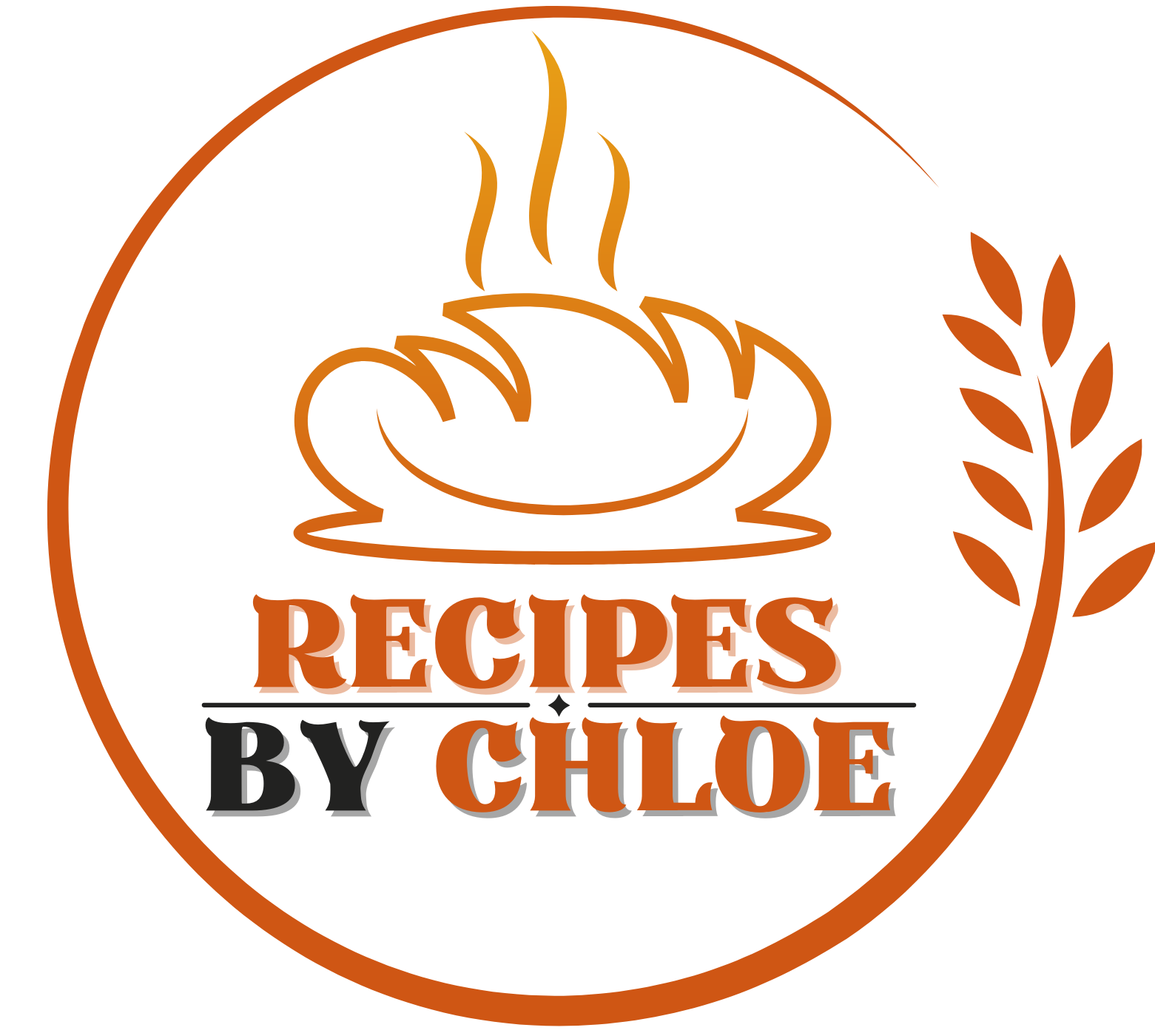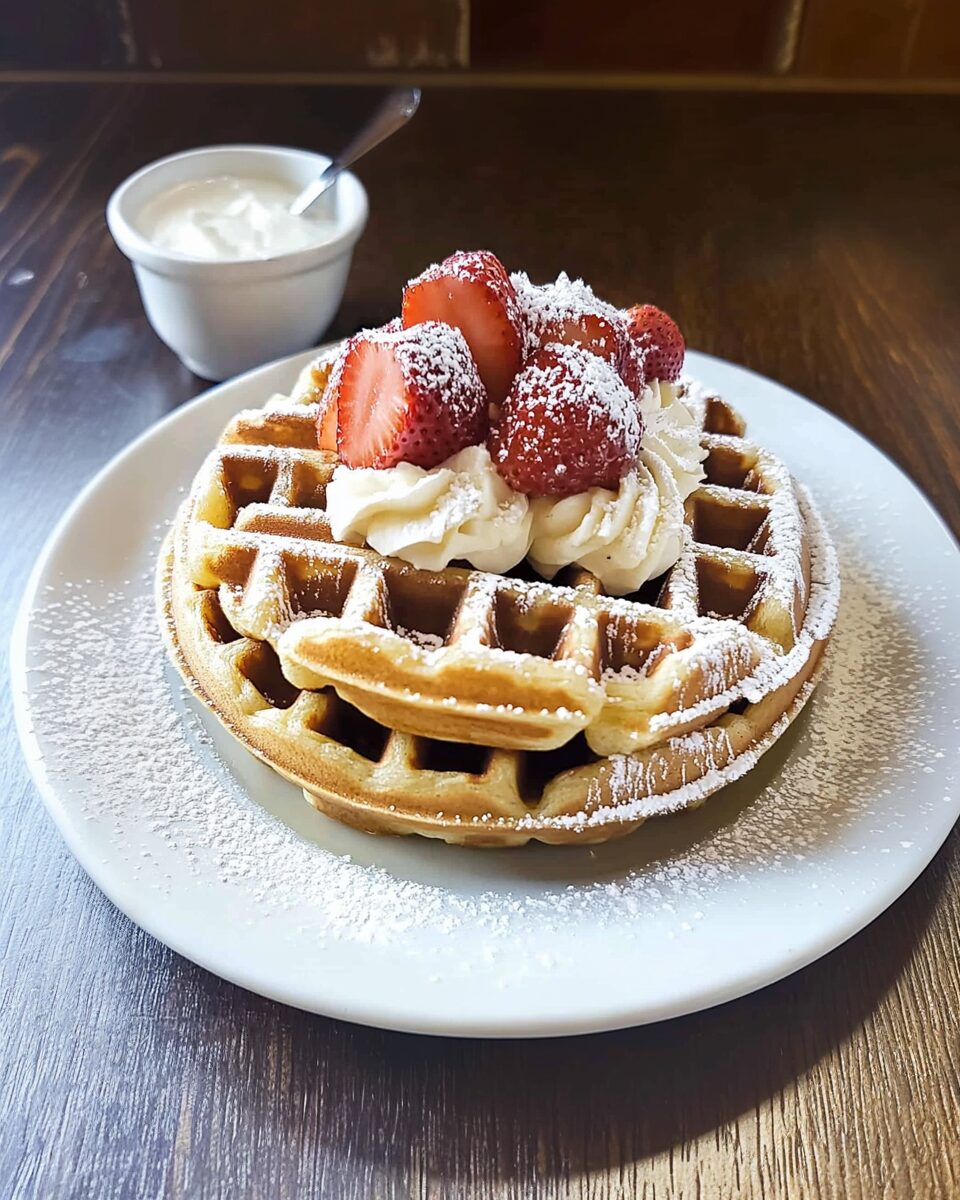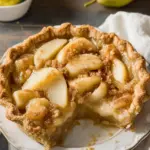Homemade Belgian waffles are a classic breakfast treat that offer a perfect balance of crispiness on the outside and a light, fluffy interior. They are easy to make, versatile, and can be customized with various toppings like syrup, fresh fruits, whipped cream, or even a dusting of powdered sugar. These waffles are perfect for a weekend brunch or as a special breakfast for your loved ones. The key to their perfect texture lies in the whipped egg whites, which help achieve that light and airy center.
Full Recipe:
Ingredients
- 2 1/4 cups all-purpose flour
- 1 tablespoon baking powder
- 3 tablespoons sugar
- 1/2 teaspoon salt
- 1 teaspoon cinnamon
- 2 large eggs, separated
- 1/2 cup vegetable oil
- 2 cups milk
- 1 teaspoon vanilla extract
Directions
- Preheat your waffle iron and lightly grease it with non-stick cooking spray or brush with a little oil.
- In a large bowl, mix together the flour, baking powder, sugar, salt, and cinnamon.
- In a separate bowl, whisk the egg yolks, vegetable oil, milk, and vanilla extract together until well combined.
- Add the wet ingredients to the dry ingredients and stir until just combined. Be careful not to overmix, as this can result in dense waffles.
- In another clean bowl, beat the egg whites with an electric mixer until stiff peaks form. Gently fold the beaten egg whites into the batter. This will make your waffles extra fluffy.
- Spoon the batter into the preheated waffle iron, following the manufacturer’s instructions for portion size.
- Cook until the waffles are golden brown and crisp. Serve immediately with your favorite toppings such as syrup, fresh fruit, or whipped cream.
Nutrients
- Calories: 300 kcal per waffle (1 serving)
- Carbohydrates: 38g
- Protein: 6g
- Fat: 14g
- Saturated Fat: 2g
- Cholesterol: 55mg
- Sodium: 330mg
- Potassium: 200mg
- Fiber: 2g
- Sugar: 5g
- Vitamin A: 100 IU
- Vitamin C: 0mg
- Calcium: 100mg
- Iron: 2mg
The History Behind Belgian Waffles
Belgian waffles have an interesting history, tracing their origins back to the medieval period. While waffles themselves date back to the early Middle Ages, Belgian waffles as we know them today were popularized during the 20th century. The iconic waffles that we recognize as Belgian waffles are thought to have been introduced at the 1962 World’s Fair in Seattle, Washington, by Maurice Vermersch, who offered a lighter, fluffier version of the traditional waffle.
Belgian waffles are often mistaken for their American counterparts, but they are distinct in both texture and appearance. The primary difference lies in the size of the grid on the waffle’s surface—Belgian waffles are typically larger with deeper pockets, which makes them perfect for holding various toppings. Over the years, Belgian waffles have evolved into a beloved breakfast or dessert option, often served at fairs, restaurants, and home kitchens alike. The name “Belgian waffle” itself has become a symbol of the delicious, indulgent waffle experience that people crave.
The Key to Perfect Belgian Waffles: Ingredients and Technique
The key to making the perfect Belgian waffle starts with the ingredients. While the ingredient list is fairly simple, the technique is what truly makes a difference in achieving that perfect texture. The batter for Belgian waffles includes basic ingredients such as flour, eggs, milk, sugar, and baking powder. However, the technique of separating the eggs and folding the whipped egg whites into the batter is what truly elevates the waffle’s texture, making it light and fluffy.
The flour acts as the foundation for the waffle batter, providing structure, while the baking powder adds the lift necessary for fluffiness. The egg yolks contribute richness and flavor to the batter, while the whipped egg whites, folded in gently, create a delicate airiness in the finished waffle. When combined, these ingredients create a waffle that is soft and airy inside, yet crisp and golden on the outside.
Another important factor is the waffle iron itself. Belgian waffle irons are designed with deeper grids to accommodate the thicker batter and create larger, fluffier waffles with deep pockets. The waffle iron’s temperature is also important for achieving a crisp exterior without overcooking the interior.
Why Homemade Waffles Are Better Than Store-Bought
While store-bought frozen waffles may be convenient, they simply cannot compare to homemade Belgian waffles in terms of flavor, texture, or customization. Making waffles at home allows you to control the ingredients and the overall quality of the dish. Unlike frozen waffles, which can sometimes be too dry or soggy when reheated, homemade waffles are crisp and tender, with the perfect balance of textures.
Homemade waffles also allow for customization. You can adjust the sweetness or flavor profile of the batter, experiment with different toppings, and create variations based on your personal preferences. Whether you prefer classic maple syrup, fresh berries, whipped cream, or a more adventurous combination of toppings, homemade Belgian waffles can be made to suit your taste.
Additionally, preparing waffles from scratch allows you to enjoy a fresh, warm breakfast that simply cannot be replicated with pre-packaged waffles. The aroma of waffles cooking in the kitchen adds to the experience, creating a cozy and inviting atmosphere that makes breakfast feel extra special.
Customizing Your Belgian Waffle Experience
One of the best aspects of homemade Belgian waffles is their versatility. While the basic waffle recipe is delicious on its own, there are countless ways to elevate your waffle experience. Here are a few ideas for customizing your Belgian waffles:
-
Toppings: The possibilities for waffle toppings are endless. You can go traditional with maple syrup, butter, and powdered sugar, or try something more decadent like fresh whipped cream, chocolate syrup, or a scoop of ice cream. For a healthier option, add fresh fruits such as berries, bananas, or peaches, or top your waffles with a dollop of yogurt or nut butter.
-
Flavor Variations: You can infuse your waffles with different flavors by adding spices such as cinnamon, nutmeg, or vanilla extract to the batter. For a richer taste, try incorporating chocolate chips, crushed nuts, or citrus zest.
-
Savory Options: While Belgian waffles are often sweet, they can also be made into savory dishes. Add ingredients like cheese, ham, or herbs to the batter to create a savory waffle that pairs perfectly with fried eggs or a salad.
-
Syrups and Sauces: In addition to traditional maple syrup, you can experiment with flavored syrups, such as berry or caramel syrup, or even make your own homemade chocolate or buttermilk syrup for a special twist.
Serving Suggestions for Belgian Waffles
Belgian waffles are versatile not only in terms of flavor but also in how they are served. They make an excellent breakfast or brunch dish, but they can also be served as a dessert. If you’re hosting a brunch, Belgian waffles can be the centerpiece of a waffle bar, where guests can choose from a variety of toppings and sauces. For a fun and interactive experience, allow everyone to customize their own waffles according to their taste.
In addition to being a star on their own, Belgian waffles pair well with other breakfast dishes. Serve them alongside scrambled eggs, bacon, or sausage for a more substantial breakfast, or pair them with a refreshing fruit salad for a lighter, fresher option. Belgian waffles also make a great dessert when served with a scoop of ice cream, whipped cream, and a drizzle of chocolate or fruit sauce.
Healthier Variations of Belgian Waffles
While traditional Belgian waffles are undeniably indulgent, it’s possible to make healthier versions without compromising flavor. You can swap out some of the ingredients to create a lighter waffle that still tastes amazing. For example, substitute whole wheat flour for all-purpose flour to add more fiber, or use Greek yogurt in place of some of the milk to boost protein content. You can also reduce the sugar in the batter or use natural sweeteners like honey or maple syrup.
For a lower-fat option, consider using egg whites instead of whole eggs and reducing the amount of oil in the batter. While these changes may slightly alter the texture and flavor, they still result in a delicious waffle that’s lighter and better for you.
Conclusion
Homemade Belgian waffles are a delightful breakfast or brunch option that can easily be customized to suit your tastes. The key to perfect Belgian waffles lies in the simple yet essential techniques, such as separating the eggs and folding in whipped egg whites, which result in a light, airy texture that is unmatched by frozen or store-bought waffles. Whether you choose classic toppings or get creative with savory flavors or unique toppings, Belgian waffles are always a crowd-pleaser.






